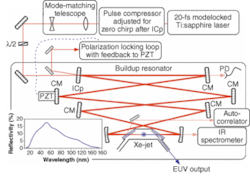Modelocking of continuous-wave lasers allows the generation of femtosecond pulses at a high repetition rate, with the spectral width of the pulses correlating with the inverse pulse duration. As is well known, a series of discrete frequencies exist below the spectral envelope resulting from the phase synchronization of the resonator modes. Theodor Hänsch and his group at Max Planck Institute for Quantum Optics (Garching, Germany) and the University of Munich (Munich, Germany) have shown that the spectrum consists of a comb of discrete frequencies at multiples of the pulse-repetition frequency. The pulse-repetition frequency lies in the radio-frequency region and can be reliably stabilized. In this way, a comb made of equidistant frequency marks can be obtained, lockable to a common reference frequency, for example an atomic clock.1
This “frequency ruler” covers the near-IR and part of the visible spectrum and can be extended to the blue more than an octave using self-phase modulation in an optical fiber. Thus, frequency measurements in the optical domain can be easily linked to a nearby frequency calibration mark as secondary standard.
Now, the same group has extended this frequency comb into the extreme-UV (EUV), making that spectral region also accessible for high-precision spectroscopy.2 The authors used harmonic generation of a primary frequency comb in the near-IR and visible using a rare-gas jet as the nonlinear medium, which led to a comb made of frequencies that were multiples of the primary comb frequencies.
In gases, only the odd multiples appear; fairly high orders can be attained if sufficient intensity at the fundamental frequencies is applied. Realizing this scheme, however, is not easy, as the highly nonlinear process is susceptible to amplitude and phase fluctuations in the primary comb. The high energies involved enable many competing processes that could reduce coherence.
The researchers started with a modelocked Ti:sapphire laser that emitted the primary frequency comb at a carrier wavelength centered at 800 nm in 20-fs pulses with a 112-MHz repetition rate and an average power of 850 mW. The pulse train was fed into a high-finesse external ring resonator, the optical path length of which was tuned to that of the primary laser cavity so that the energy of any optical pulse circulating in the ring resonator was increased by the input pulses until an equilibrium with resonator losses was reached (see Fig. 1).
The in-coupling mirror had a transmission of 1%, allowing a resonator finesse of 100. In practice, a power enhancement of 54 was achieved in the resonator, leading to 38 W of circulating optical power. Chirped mirrors in the resonator minimized group-velocity dispersion within the resonator caused by air and intracavity Brewster windows. A prism compressor before the resonator shaped the pulses to be shortest at the harmonic-generating medium.
Xenon gas jet
To generate high harmonics, a xenon gas jet was passed through the resonator focus, which had an estimated intensity of 5 × 1013 W/cm2. The jet was brought into a small vacuum tube closed with sapphire Brewster windows. Higher-harmonic radiation at EUV wavelengths appeared collinearly with the circulating optical pulses. Because the index of refraction of sapphire is below unity for EUV, radiation can be coupled out at the Brewster window, taking advantage of total external reflection in the EUV region.
Analyzing the EUV radiation showed generation of up to the 15th order at about 55 nm, corresponding to a photon energy of 23 eV (see Fig. 2). The highest power was measured for the ninth order near 90 nm. The third order could be observed with the naked eye, the fifth order could not be displayed by the spectrometer.The crucial experiment was verifying the comb coherence. A beat measurement was performed between the third harmonic from the enhancement resonator and the fourth harmonic of a modelocked 5-ps Nd:YVO4 (vanadate) laser that emitted its own frequency comb known to “survive” solid-state fourth-harmonic generation. The corresponding center wavelengths differed by less that 1 nm. Pulse synchronization of both lasers was performed by phase-locking the second harmonic of the Ti:sapphire laser repetition rate (set to 114 MHz) to the third harmonic of the Nd:YVO4 laser repetition rate (76 MHz) so that every second pulse coincided with a third pulse from the former.
The signal was frequency-analyzed by a fast-Fourier-transform algorithm. Beat signals between both frequency combs were obtained at various frequencies. In addition, the spatial coherence of the harmonics was measured, yielding divergence angles of 14, 11, and 10 mrad for the 7th, 9th, and 11th harmonics, in approximate agreement with the diffraction limits. The total power in the range from 120 to 60 nm was measured to be greater than 1 nW after the sapphire window.
The authors believe that milliwatt levels in the EUV may become possible, allowing EUV interferometry, holography, and lithography. With its repetition rate a thousand times higher than former EUV-generation experiments, the emitter already satisfies requirements for spectroscopy, promising unprecedented accuracy in that spectral region.
REFERENCES
1. R. Holzwarth et al., Phys. Rev. Lett. 85 (11) 2264 (2000).
2. C. Gohle et al., Nature 436, 234 (July 14, 2005).
About the Author
Uwe Brinkmann
Contributing Editor, Germany
Uwe Brinkmann was Contributing Editor, Germany, for Laser Focus World.

